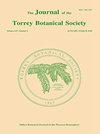阿迪朗达克北部阔叶林中腐木作为维管植物栖息地的林分效应[j]
IF 0.8
4区 生物学
Q4 PLANT SCIENCES
引用次数: 39
摘要
GREGORY G. MCGEE(纽约州立大学环境科学与林业学院,1 Forestry Drive, Syracuse, NY 13210)。阿迪朗达克北部阔叶林中腐木作为维管植物栖息地的林分效应。托里·博特。Soc。128:370 - 380。2001.-本研究的目的是确定(1)腐烂的原木是否为阿迪朗达克北部硬木林中的任何维管植物提供了重要的栖息地;(2)林分尺度环境因子的变化是否会影响腐木作为维管植物栖息地的作用。研究了北方三种阔叶林类型(原生林、部分采伐林和15 ~ 29年林龄防护林)的腐木和邻近林地微点上草本分株密度和木本苗/幼树基面积的特征。普通草本植物不局限于原木微站点,但中间毛蕨在原木上的密度较大。白桦、加拿大杉木和冷杉在腐烂原木上的基部面积(根颈直径为15.0 cm)都较大,而林下槭、糖槭、大叶Fagus和桤木在森林地面微点上的基部面积较大。林分的木本茎基面积平均(+ 1 SD)最大(1775 + 615 mm2 m-2),而部分砍伐的林分(714 + 266 mm2 m-2)和原生林(503 + 657 mm2 m-2)的林分最大(+ 1 SD)。阿勒格尼贝贝在林基面积中占相当大的比例。在这些防护林林分中,在森林地面和原木微点之间没有统计学差异(P = 0.07)。而在部分采伐的林分中,阿勒格尼布林在腐木微站点上的基底面积更大(P = 0.05)。在原生林中,未取样到直径为0 ~ 2 cm的阿勒甘尼松茎。研究表明,在北方阔叶林中,腐木为某些树种和蕨类植物提供了早期的生长场所。虽然阿勒格尼布林偏爱原木作为部分砍伐林分的建立地点,但该物种能够在整个防护林林分中广泛建立。尽管阿勒甘白杨很容易在腐烂的原木上发芽,但其向更大的幼树类别的招募似乎始终受到林分水平变化因素(如光照水平)的限制。本文章由计算机程序翻译,如有差异,请以英文原文为准。
Stand-level effects on the role of decaying logs as vascular plant habitat in Adirondack northern hardwood forests1
GREGORY G. MCGEE (State University of New York-College of Environmental Science and Forestry, 1 Forestry Drive, Syracuse, NY 13210). Stand-level effects on the role of decaying logs as vascular plant habitat in Adirondack northern hardwood forests. J. Torrey Bot. Soc. 128:370-380. 2001.-The objectives of this study were to determine (1) if decaying logs provide critical habitat for any vascular plants in Adirondack northern hardwood forests; and (2) whether environmental factors that vary at the stand-scale influence the role of decaying logs as vascular plant habitat. Herbaceous ramet densities and woody seedling/sapling basal area were characterized on well-decayed logs and adjacent forest floor microsites in three northern hardwood stand types: old-growth, partially-cut, and 15to 29-year-old shelterwoods. No common herbaceous species were restricted to the log microsites, although Dryopteris intermedia had greater densities on logs. Betula alleghaniensis, Tsuga canadensis and Abies balsamea all attained greater basal areas (stems --15.0 cm diameter at the root collar) on decaying logs, while Acer pensylvanicum, Acer saccharum, Fagus grandifolia and Viburnum alnifolium had greater basal areas on forest floor microsites. Average (+ 1 SD) total basal area of woody stems was greatest in the shelterwoods (1775 + 615 mm2 m-2), compared to the partially-cut (714 + 266 mm2 m-2) and old-growth (503 + 657 mm2 m-2) stands. Betual alleghaniensis accounted for a substantial proportion of the basal area in the shelterwoods. In these shelterwood stands B. alleghaniensis basal areas were not statistically discernible between the forest floor and log microsites (P = 0.07). However, in partially-cut stands, B. alleghaniensis basal area was greater on the decaying log microsites (P = 0.05). In the old-growth stands, no B. alleghaniensis stems > 2 cm diameter were sampled. This study indicates that decaying logs provide early establishment sites for some tree species and the fern, D. intermedia, in northern hardwood forests. While B. alleghaniensis favored logs as establishment sites in the partially-cut stands, this species was capable of widespread establishment throughout the shelterwood stands. Even though B. alleghaniensis readily germinated on decaying logs, its recruitment into larger sapling size classes appeared to be consistently limited by factors varying at the stand level (e.g., light levels).
求助全文
通过发布文献求助,成功后即可免费获取论文全文。
去求助
来源期刊
CiteScore
0.70
自引率
0.00%
发文量
16
审稿时长
>12 weeks
期刊介绍:
The Journal of the Torrey Botanical Society (until 1997 the Bulletin of the Torrey Botanical Club), the oldest botanical journal in the Americas, has as its primary goal the dissemination of scientific knowledge about plants (including thallopyhtes and fungi). It publishes basic research in all areas of plant biology, except horticulture, with an emphasis on research done in, and about plants of, the Western Hemisphere.

 求助内容:
求助内容: 应助结果提醒方式:
应助结果提醒方式:


